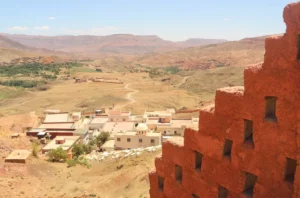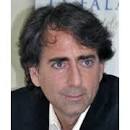The Keys to Addressing People’s Needs in Morocco | Yossef Ben-Meir (Morocco
Participatory Interfaith Dialogue

The burial place of the venerated Rabbi David-ou-Moshe as seen from the entryway to the adjacent hilltop fruit tree nursery.
By Yossef Ben-Meir (Morocco 1993-95 & APDC 1998-99)
| Twenty-nine years ago, I was a Peace Corps Volunteer living in a mountainous High Atlas village called Amsouzerte, near the southern side of Morocco’s Toubkal National Park. Back then, the journey from the village to the nearest city centers took almost 20 hours along unpaved roads and mountain passes. At the foot of a mountainside, fifty kilometers from Amsouzerte, I would sometimes catch sight of an old, white mausoleum that seemed misplaced among the earth-brick homes characteristic of rural Moroccan landscapes.
Looking upon this eroding mountain area, I could envision huge swaths of terraces constructed above the mausoleum for the local Muslim community to build tree nurseries and derive generational benefits. Tree nurseries are very valuable for Moroccan farming communities because 70 percent of agricultural land in the country generates only 10-15 percent of agricultural revenue. Fruit tree cultivation allows farming families to transition from less lucrative barley and corn crops and generate higher income. Later, I learned that the mausoleum is a sacred tomb of a Hebrew saint (tzaddik, or ‘righteous one’) named David-Ou-Moshe, one of over 600 tzaddikim (Muslim, Jewish, and Christian) buried throughout Morocco. I realized the land around these burials could be leveraged for future tree nurseries, potentially generating tens of millions of saplings annually. How did I know that the people desired trees? As a Peace Corps Volunteer, we were trained to listen to them. Thus, this project and the work of the organization I co-founded in 2000, the High Atlas Foundation, are based on Moroccan communities’ determination and development perspective. Small-land holders often cannot designate the necessary nursery plot resources over the two years required for fruit tree seeds to mature; they must harvest every season from every available square meter to maintain their livelihoods. Thus, the question that arose then and remains prevalent for rural communities is where do we acquire the land for nurseries to maximize our planting yields? On behalf of the farming families, I approached the Moroccan Jewish community to request land leases for building tree nurseries. They agreed, but the project still needed funding. However, many years passed, and the originally intended location remained undone, despite launching a successful pilot nursery at Akrich in the Al Haouz province near Marrakech at the burial site of the tzaddik Raphael Hacohen. Community nurseries jumpstart a new development path toward economic and environmental sustainability. The Akrich tree nursery (financially assisted by Ecosia and FENELEC), for example, led to Imagine empowerment workshops and the nearby Achbarou Women’s Carpet-Making Cooperative; a paved road now being built between the nursery/cemetery and the Cooperative, allowing visitors to easily to both sites; and a clean drinking water system in Achbarou village (funded by Yves Saint Laurent Fashion). It, therefore, is incumbent that agencies partner with these communities as land contributors to catalyze human development projects beyond the agricultural sector. In recent years, the global community has been harshly reminded that much of the world does not reflect Morocco’s inspiring faith and cultural solidarity model. The killers at two mosques in Christchurch, New Zealand, in 2019, an AME church in South Carolina in 2015, and the Or L’Simcha Congregation (Tree of Life) synagogue in Pittsburgh in 2018 were each warmly greeted with “Salaam” and “Welcome” and “Shalom. The potential nursery near Amsouzerte (and the success of the Akrich project) would juxtapose these devastating events, instead epitomizing the hopeful reality of interfaith solidarity in Morocco. Thus, in my role as President of the High Atlas Foundation, I decided to pen a brief letter to His Majesty King Mohammed VI of Morocco: “We write, moved by a troubling time, and in complete belief that Morocco can redirect humanity’s course like no other nation by its ability to simultaneously affirm multicultural unity and alleviate people’s burden. This one project can catalyze to achieve all of this.” I hand-delivered the letter to the Royal Palace in Rabat. Within the month, the Ouarzazate Governor called to meet and discuss the implementation of this tree nursery with the Regional Directors of all relevant public agencies and our organization. For twenty-five years, I had held fast to the dream of this nursery; its construction began two months following our appeal to the King, with two-thirds of the funding supplied by Morocco’s National Initiative for Human Development (NIHD), a donor strategy first broached in 2006. In addition to the Moroccan Jewish Community, the High Atlas Foundation also receives public land in-kind from Morocco’s National Agency for Water and Forests, enabling the planting of 4 million trees from 2003 until today. The first million trees took 14 years to plant. In 2023 alone, HAF is transplanting 1.7 million trees from 15 nurseries to benefit 10,000 farming families in 160 municipalities and building four new nurseries. Two of these new nurseries are on land from the Moroccan Jewish community (50 percent funded by NIHD), next to the burial sites of the tzaddikim Rabbi Moul Almay in Sidi Rahal outside of Marrakech and Rabbi Haroon Abou Hassira in Telouet of the Ouarzazate province. The name given to the interfaith organic fruit tree initiative by the Governor of the Al Haouz Province, Younès Al Bathaoui, is House of Life, denoting the traditional title for a Jewish cemetery. Morocco’s policies encourage intercultural dialogue and communication for human development. Different faith communities in Morocco are brought together to share their historical narratives, which can lead to improved livelihoods and health through a participatory development approach by leveraging underutilized capacities. However, these necessary experiences to empower and promote sustainable growth are too infrequent to impact social transformation. House of Life cements the continuity of interfaith collaboration, which is key for achieving scale and social change, by providing needed trees and support for new community projects. On the one hand, while multicultural memory and consciousness in the country create opportunities, combining these factors has yet to reach the level of self-reliant development and a circular economy that the people urgently need. Through the USAID Dakira (or “Memory” in English) program, civil society organizations and public administrations seek to redress the lack of such participatory community dialogues in which people discuss the past and the future together and create a shared vision forward. The most significant challenge for participatory planning is the need for more training on community dialogue facilitation to empower all voices and express all priorities. While manifold methods and activities can be used to explore personal and collective identity and create plans for the future, most people, including Moroccans, have never experienced these approaches and are, therefore, unable to initiate and steward the process. Interfaith dialogue – the opportunity to voice our histories – can deepen understanding and provide reconciliation between historically antagonistic groups if sought. When this process is maintained and integrated with supporting projects, defined and managed by the people, it can become a basis for achieving sustainable and prosperous societies. In Morocco, interfaith connections are convivial when they occur but demand total energy and commitment to organize. Taking this Moroccan approach to succeed across religious differences, we could inspire other nations of Africa, the Islamic World, and the Middle East. •Dr. Yossef Ben-Meir is president and co-founder of the High Atlas Foundation, a Moroccan-U.S. nongovernment organization founded in 2000 and dedicated to sustainable development. Dr. Ben-Meir is currently a visiting professor at the University of Virginia’s International Studies. He holds a Ph.D. in sociology from the University of New Mexico (2009), where he also taught, an MA in international development from Clark University (1997), and a BA in economics from New York University (1991). The article was completed with the support of the United States Agency for International Development (USAID), and the High Atlas Foundation is solely responsible for its content, which does not necessarily reflect the views of USAID or the Government of the United States. |

I’m impressed. You’ve found a solution that could be adapted to many problems in many societies. Hats off to your hard work and commitment.
No wonder you succeeded! David ou Moshe is one of the most famous tzaddikim among Moroccan Jews, ans has been venerated by some Muslims as well. No doubt he lent his assistance! Morocco is dotted with these tombs, and many Jews from Israel still travel to visit them. You may be interested in the book Saint Veneration Among the Jews in Morocco, by Issachar Ben-Ami, which gives a full and fascinating account. Good luck with your work.
This is an impactful and scalable project.I hope it gets replicated across Morroco and beyond
This is an impactful and scalable project. I hope it gets replicated across Morrocco and beyond